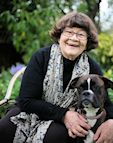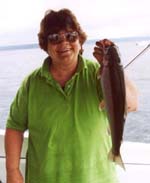
Photo taken by Joy's grandson Weston
Featherston 5740
New Zealand
September 2021
Dear Friends,
Writing History
I am now 85 and hugely grateful for a story-telling gift that became useful as it developed, guided by love of reading. Iím aware that such a gift could have taken a darker path of lies, manipulation and ultimately, mental illness. I have seen this happen in others and never cease to be thankful to all the guardian angels in my life, friends, teachers, librarians, editors, who have been my guides.
Now, in the last stages of life, I am losing my sight. I am also aware that my books are known in most countries, and that some people with the best of intention, are writing my literary history for me. It is time I wrote it for myself.
Contrary to expectation, I was slow to become a reader. The eldest of what would eventually be a family of five, my story-telling" found expression in pictures. Drawing was a passion evoked by any clear surface, wallpaper, the end pages of my fatherís library books and my motherís Bible. With a piece of broken brick I could make huge pictures on the footpath outside our house.
These efforts didnít always please my parents or our neighbours.
I was told that when I started school, I would learn to read. That didnít happen. My parents had ill health and we moved house several times. By seven years of age, Iíd been to five different schools and was convinced that I was a "bad reader."
Several factors contributed to this, the main one being I was a visual learner confronted with an old phonics reading system. We learned letters, then two letters together, short words, longer words, sentences. It was a long time before we got to story.
During this time, the world was at war. Young teachers were called to work on the land, and older teachers came out of retirement. Classrooms were crowded and children like me were left alone if we were quiet and well behaved.
Schools did not have libraries but when the, School Library Service van came, books were handed out.
I was eight, and the book put on my desk was the story of "Ping" the little duckling. Other children in that class were given novels like "Treasure Island" or "Alice in Wonderland" or "Tom Sawyer". But I was happy with my picture book. The few reading skills I had learned, came together in that simple text, and I had a "story". In the safety of my desk, I got lost with Ping on the Yangtze River, was rescued and came safely home. I didnít want the story to end, so I did what children usually do, went back to the beginning and read it again. The story was exactly the same! I had discovered the constancy of print!
It seemed that I became instantly, an avid reader. I know it didnít happen like that, but there had been some kind of breakthrough with Ping, some awareness that I could access story through print on paper.
My father took me to the town library. It didnít have a childrenís section, but a wise librarian guided me to the "Classics" in the adult section and I was soon reading books by Robert Louis Stevenson, Alexander Dumas, Mark Twain, Walter Scott. I expect I simply skipped over words I didnít understand. I lost myself in stories, reading a book as I walked to school, reading a book in my lap in class while answering the teacherís questions, reading at night under the blankets with my fatherís torch. I also regurgitated aspects of my reading to create stories for my younger sisters. From the age of ten, a full blown reader was also becoming a writer. I had stories and poems published in the Childrenís Page of the Southern Cross newspaper, and at school was asked to read my poems in front of the class. The memories of failure soon faded.
Secondary education was at Palmerston North Girls High School, about 25 miles from my home in Foxton. I travelled by bus each day and found in that school a group of women who were caring and inspiring. My art and writing flourished.
At he beginning of the sixth form, my University Entrance year, my parents wanted me to leave school. They said I had school certificate which was enough to get me a job, and I needed to earn money to help support the family. I told my teachers I had to leave school.
I didnít know what communication the school had with my parents, but it was arranged that during the school week I would stay in Palmerston North with a family who lived near the school, and have an after-school job that would pay for my lodging and also provide money for my parents when I went home at the weekends.
And the job those teachers found for me? I became the editor of the Childrenís Page of the Manawatu Daily Times. This, at the age of 16! I was in heaven! In the newspaper office, I had a desk and typewriter in a small room I shared with the editor of the Womenís Page.
I ran competitions, published childrenís writing and wrote editorials about my imaginary dog called Crackers who was always in trouble. Sometimes Crackers would get to the typewriter and write a story about me. It was all wonderful, and I managed to keep up with schoolwork, and earn University Entrance. At the end of the year I knew I would have to leave school. The Editor of the Manawatu Daily Times offered me a full time job as a cadet reporter.
In those days, it was boys who became cadet reporters, and I could not wait to tell my parents the great news. Mum and Dad were not impressed. They said that newspaper people were either Atheists or Communists and I had been too much under their influence already. I was to live at home. They had found me an apprenticeship to the local chemist.
I had no ambition to become a pharmacist, and had not done chemistry or maths at school. I worked in the dispensary, did papers by correspondence. The next two years were difficult but they gave me discipline, and that was an important gift to a creative imagination.
In the pharmacy years I had a motorbike and also learned to fly Tiger Moths at Middle Districts airport Palmerston North. I was there when I met a young farmer Ted Cowley and we were married in 1956.
In the next five years we had four beautiful children, and I started writing again. I was back in heaven, working on the farm, enjoying motherhood and getting an occasional short story published in the New Zealand Listener. There were also stories for children, written for the NZ School Journal. and several stories for the Price Milburn early readers.
In the early 1960s, a NZ Listener story was reprinted in Short Story International. In New York, a Doubleday editor bought a copy in Grand Central station and was interested in my story. I donít know how she got my mailing address, but I received a Doubleday letter asking if I had a novel.
What do you say when an American publisher asks if you have a novel? I replied that I was thinking about it, which was true for the moment. But a week or so later, I decided a novel would be impossible.
Six months later, the editor Anne Hutchens sent another letter. "How is that novel coming along?"
I sat down, wrote a story I thought could be the first chapter of a novel, and sent it away. Back came a contract and the promise of half an advance royalty when the contract was signed.
With the money I was able to get live-in help in the house, while I wrote "Nest in a Falling Tree". When it was published, Roald Dahl bought the film rights to make a movie for his wife Patricia Neal who was recovering from a stroke. It was a lot of money that eventually bought the property in Kenepuru Sound.
I wrote five novels for Doubleday, but my heart was in writing early reading material for children. My son Edward wasnít as interested in reading as were his siblings. His teacher suggested I write to him, and she gave me a Dolsch word list. She held up the school reader Janet and John (which was the old American Dick and Jane). She said, "There is no reason why any child would want to read this."
I remembered my own struggles with words and the crippling fear of failure. I began working with children after school. Like my Edward, they had lost all interest in school books.
In our sessions, we did not have books. We started with story talk. What did they do last Friday? What do they want for Christmas? What is your favourite food? If you could have anything you wanted, what would it be?
This started conversation. Children told their own stories. As they spoke, I typed the story in the third person, with the childís name in the title and throughout the story. The child took the top story home to be read to them by a parent. I used the carbon copy to reduce the content, draw pictures, and make a little book.
No child was ever reluctant to read his or her book.
Those children taught me so much about writing for children:
- Children are not tense when they are laughing.
- Putting a surprise or a joke at the end of a story was like having dessert after vegetables.
- The child was never wrong. The fault was always with the word. Some words are higgly-piggly tricky!
In the 1970s teachers were making big books for shared reading. Some used stories I had written, and they asked if I could get these stories published. I tried, but no publisher was interested. My husband thought we should publish them ourselves. To do this, I needed to work out pagination for the stories and I consulted June Melser, an ex teacher who was working as an editor for School Publications. Would she help with the layout? June was enthusiastic. I didnít know that she was having some retold folk tales published by an Auckland woman who wanted to become a publisher of childrenís early reading books. Nor did I know that June has sent this woman my stories. This was not what I had planned. But I did go to Auckland to meet this woman. She was a young Australian who had high energy and intelligence, and I was impressed. Her name was Wendy Pye.
Of course, Dame Wendy Pye is now known throughout the world, as are her books, but in the 1970s we all had small beginnings. We called the first twelve books "Story Box" and hoped they would fill a gap for NZ teachers. We didnít know they would go around the world and teachers would be calling, "More, more, more!"
So there you are. Those are the beginnings. In the next letter, Iíll bring you up to date.
Blessings, dear Friends
Joy Cowley

